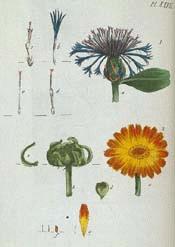
Botanical.com Home Page

|
Cornflower
(Centaurea montana)
Click on graphic for larger image
|
Cornflower
Botanical: Centaurea Cyanus (LINN.)
Family: N.O. Compositae
---Synonyms---Bluebottle. Bluebow. Hurtsickle. Blue Cap.
(French) Bluet.
---Part Used---Flowers.
- Centaurea Cyanus, the Cornflower, with its star-like blossoms of brilliant blue, is one of our most striking wild-flowers, though it is always looked on as an unwelcome weed by the farmer, for not only does it by its presence withdraw nourishment from the ground that is needed for the corn, 'but its tough stems in former days of hand-reaping were wont to blunt the reaper's sickle, earning it the name of 'Hurt Sickle':
- 'Thou blunt'st the very reaper's sickle and so
- In life and death becom'st the farmer's foe.'
The Latin name, Cyanus, was given the Cornflower after a youthful devotee of the goddess Flora (Cyanus), whose favourite flower it was, and the name of the genus is derived from the Centaur, Chiron, who taught mankind the healing virtue of herbs.
It has long been cultivated as a garden plant, in several colours as well as white. C. montana, a perennial form, is frequent in gardens.
[Top]
---Description---In the wild condition it is fairly common in cultivated fields and by roadsides. The stems are 1 to 3 feet high, tough and wiry, slender, furrowed and branched, somewhat angular and covered with a loose cottony down. The leaves, very narrow and long, are arranged alternately on the stem, and like the stem are covered more or less with white cobwebby down that gives the whole plant a somewhat dull and grey appearance. The lower leaves are much broader and often have a roughly-toothed outline. The flowers grow solitary, and of necessity upon long stalks to raise them among the corn. The bracts enclosing the hard head of the flower are numerous, with tightly overlapping scales, each bordered by a fringe of brown teeth. The inner disk florets are small and numerous, of a pale purplish rose colour. The bright blue ray florets, thatform the conspicuous part of the flower, are large, widely spread, and much cut into.
---Part Used Medicinally---The flowers are the part used in modern herbal medicine and are considered to have tonic, stimulant and emmenagogue properties, with action similar to that of Blessed Thistle.
A water distilled from Cornflower petals was formerly in repute as a remedy for weak eyes. The famous French eyewash, 'Eau de Casselunettes,' used to be made from them. Culpepper tells us that the powder or dried leaves of the Bluebottle is given with good success to those that are bruised by a fall or have broken a vein inwardly. He also informs us that, with Plantain, Horsetail, or Comfrey,
'it is a remedy against the poison of the scorpion and resisteth all venoms and poisons. The seeds or leaves (or the distilled water of the herb) taken in wine is very good against the plague and all infectious diseases, and is very good in pestilential fevers: the juice put into fresh or green wounds doth quickly solder up the lips of them together, and is very effectual to heal all ulcers and sores in the mouth.'
The expressed juice of the petals makes a good blue ink; if expressed and mixed with alum-water, it may be used in water-colour drawing. It dyes linen a beautiful blue, but the colour is not permanent.
The dried petals are used by perfumers for giving colour to pot-pourri.
See:
KNAPWEED, BLACK
KNAPWEED, GREATER
SCABIOUS, FIELD
SCABIOUS, LESSER
SCABIOUS, DEVIL'S BIT
TEAZLE
Common Name Index
A MODERN HERBAL Home Page
Bear in mind "A Modern Herbal" was written with the conventional wisdom of the early 1900's. This should be taken into account as some of the information may now be considered inaccurate, or not in accordance with modern medicine.
© Copyright Protected 1995-2025 Botanical.com
|

